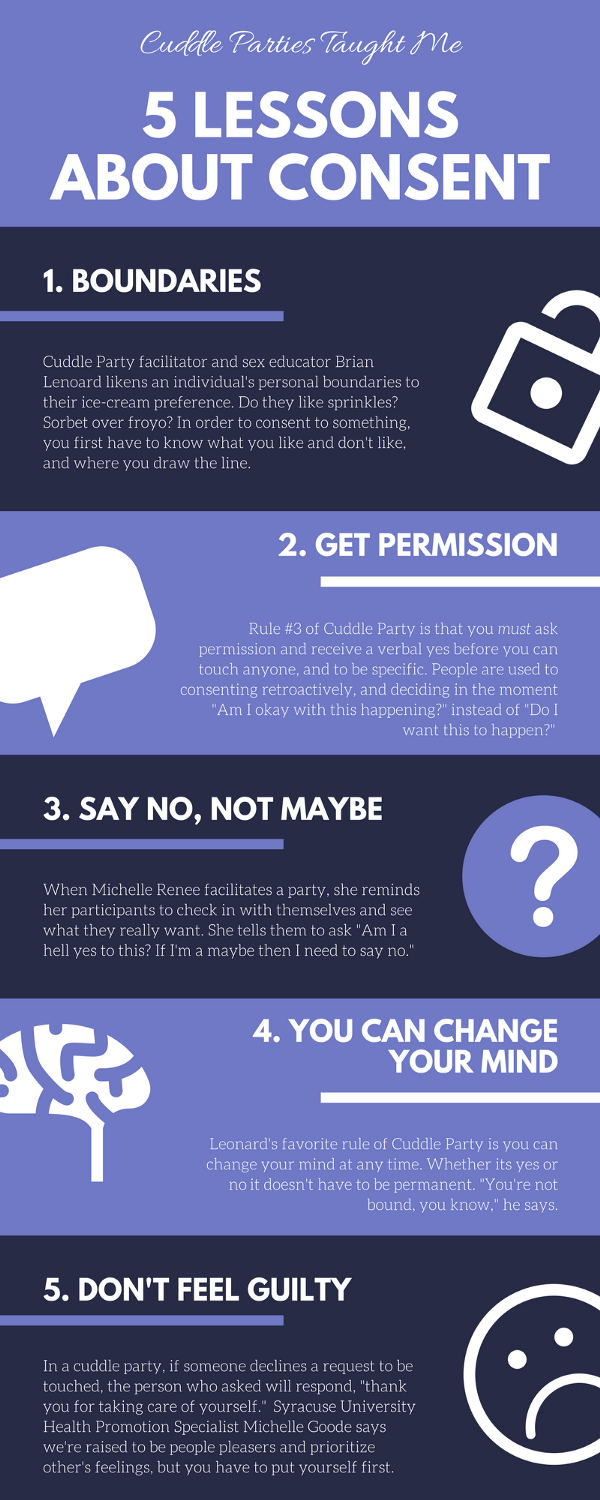Spoonful of strangers: A look inside the cuddling business
Inside the cuddling business

On a brisk, fall Saturday afternoon in a small slice of the Upper East Side, 28 men and women gather in a loft with the goal of cuddling with a stranger. A full-figured woman with tattoos and a shaven head clutches her teddy bear. A burly veteran, clad in blue flannel pajama pants, shares that he is open to talking about his struggles with mild PTSD. Event facilitator Adam Lippin smiles, greets guests, and moves through the crowd in white Adidas joggers, jeans, and a purple shirt. Soft jazz floats through the apartment, and the faint scent of feet lingers in the air. The kitchen features trays of snacks and lines of bottled water as people mill about, chat, and munch on fruits and nuts as they wait for the 3:30 p.m. start time. Two people hold up a curtain on a rod to create a make-shift changing room. Attendees briefly disappear behind the curtain and emerge in clothes that resemble sleepwear. At 4:04 p.m., the cuddling begins.
Before the first embrace, Lippin explains the rules and boundaries of this three-hour cuddling session. He describes this apartment, covered in pillows, blankets, and mattresses, as a sacred space. The whole room laughs as he advises: “If you see someone on the street, avoid running up to them and saying, ‘So how about that f—— cuddle party last night, right?’” It is a reminder that an event like this still remains misunderstood to the majority of the public.
Feel good business
Welcome to a cuddle party, a group event that promotes non-sexual touch, boundary setting, and communication, and this is just one of many opportunities from around the globe for strangers to gather and embrace. The Cuddle Party company, for example, has expanded in the past 13 years to 18 different locations, including international cuddle parties in Ireland, Australia, and Canada. But cuddle parties are just one example of cuddling services that make up the growing cuddling business. Cuddlist, one of the many professional one-on-one cuddling companies, was co-founded by Lippin, and features about 200 certified cuddlers, professionals who have completed the company’s training across 17 states as well as Canada and the United Kingdom. Spoonr, a Tinder-esque app for cuddling that shut down in January 2017, allowed users to meet up with strangers around them for a cuddling session. Websites such as Cuddle Comfort boast more than 86,000 members who seek someone in their area to cuddle. In 2015, a cuddling convention called Cuddle Con took place in Portland, Ore.
Even though a growing number of cuddling services exist today, the first cuddle party parties date back to almost a century ago, when they exploded in the 1920s. Then called “petting parties,” “spooning,” and “snugglepupping,” these gatherings earned a more scandalous reputation. Far more sexual in nature than the modern cuddle business, these events featured groups of couples who would get together to experience explorative touch that always stopped before sex. The cuddle operations of today began in Oregon in 2002. A few years later, the cuddle phenomena stretched across the country to New York with the founding of Cuddle Party in 2004. Despite common misconceptions, the modern cuddling business still struggles to eliminate the sexual connotations associated with those original cuddle parties of the 1920s.
Physical connection
Professional cuddler Michelle Renee received her professional cuddling certification from Cuddlist, and admits that even when she’s not on the job, she notices she likes to touch her friends when she talks to them. She loves the connection it creates and touch’s ability to signal that she’s present and there for that person. But she also deals with the misconceptions regarding the sexual nature her profession. Although arousal sometimes occurs during sessions, Renee emphasizes the non-sexual nature of one-on-one cuddle sessions and screens her clients to make certain platonic touch is their sole intent. In fact, she believes what her clients lack in their lives is platonic — not sexual — touch and that the high-tech, low-touch digital age makes us less physically connected than ever before (and therefore in need of a good snuggle). When considering her clients, Renee says this lack of touch is particularly prevalent in middle-aged men.
A study by Canadian psychologist Sidney Jourard, who counted the number of times groups from different cultures platonically touched during a one-hour period, reinforces the absence of touch in American life. In that study, Puerto Ricans touched each other 180 times; the French, 110; Americans, twice; and the British, zero. “You could think of us more as a touch-deprived culture potentially if you don’t have a romantic relationship or close friendships where you’re engaging in that kind of touch,” says Brittany Jakubiak, author of Affectionate Touch to Promote Relational, Psychological, and Mental Well-Being in Adulthood. Because of that, she says she understands why people might turn to the cuddling business. The AARP Loneliness Study, which surveyed a sample of more than 3,000 adults age 45 or older in 2010, also gives some insight into the effects this lack of touch has on the general population and where the cuddling business might offer some relief. The survey found that 35 percent of people living in the United States suffer from loneliness — up from the 20 percent reported in 1980. In addition, one quarter of U.S. households consist of only one person. Because marriage rates and number of children per household continue to decline, more and more people live alone in social isolation, leading to a decrease in overall health.
Knowing what you want
Lippin founded Cuddlist because of this lack of touch in people’s lives, and because he saw this missing as an option to help people live happier and healthier. “Culturally, we’re messed up,” he says. And in order to contribute something to the greater good, Lippin left behind his life as an owner of Atomic Wings to become the CEO and co-founder of Cuddlist, a cuddler-for-hire business, in January 2016 as a way to provide people with the one thing therapists can’t do: touch. In fact, “therapy,” “medicinal,” and “holistic healing” are all words that come up frequently within the cuddling community. Despite the common use of hiring a professional cuddler or attending a cuddle party to fulfil a lack of platonic touch in day-to-day life and create and foster a connection, alternative uses of the cuddle business also play an important role. Cuddle party attendees Belinda and Kevin Porter have been married for almost 30 years and love the consent aspect of these gatherings. The Porters say it’s important to learn and teach consent inside but also outside of a sexual context. Mrs. Porter says cuddle parties are a great place to practice saying no in a safe container. “Easy word, hard to say. We need to learn to be a society that asks and accepts no,” she says.
Professional cuddler Renee had one of her cuddle party attendees learn the power of saying no when she was going through training and facilitated her first cuddle party. Renee says she received feedback from the participant thanking her for learning to say no. “She’s online dating, and she had an offer for a date and she used to say yes out of obligation,” Renee says. “She said it was because of coming to my party that she realized she could say no. And it seems so simple, but people just don’t have practice in it.”
Other than the purpose of boundary setting and learning about consent, the cuddling business also seeks to gain more credibility as an alternative health treatment along the likes of somatic therapy or massage therapy. Syracuse University education assistant professor Suzanne Oliver pursued three years of somatic therapy certification (a holistic therapy that studies the relationship between the mind and the body in regards to the psychological past) by learning The Alexander Technique in order to understand how to work the body and the biomechanics of the human form. She says she can see how the cuddle business could provide something massage and somatic therapy cannot. “There’s a lot of respect that goes into being an accomplished person with your hands,” she says. “I think if this is done right, it can be very nourishing for people. There’s so much loneliness in our world.”
Lippin has seen this nourishment first-hand in his experiences, and it is a path he hopes Cuddlist and the cuddling business will explore further. He loves to share stories of people who hired professional cuddlers and reaped unbelievable benefits. One client with Parkinson’s described their nervous system as quiet after a session. Another client with multiple sclerosis stopped shaking for three days after his cuddle session. Lippin says he sees a lot of potential in the business with veterans suffering from PTSD and hopes to branch out to that are within the next year. But until then, he will continue to grow his business and facilitate cuddle parties such as the one he organized in New York City.
The safe, soft space
Lippin possesses a natural talent in leading a cuddle party and maintaining the space. He serves as a physical reminder of the rules and boundaries, which he repeats to the crowd, and he serves as an attentive listener to those who want to open up. But he does not allow his presence to overtake the room, and he does not participate in the massage trains, puppy piles, or spooning sessions. He leaves the attendees to stare intimately into each other’s eyes in silence or talk about their days while intertwined. There is a buzz of both quiet chatter and a warm kind of energy in the ruby-red room four flights up.
Almost three hours pass, the sunsets, and the time available to touch and be touched in the safe, soft space has expired. Lippin announces that it is time to create the closing circle. Some people have to be roused awake from their naps while others smile lazily at each other, stroking a hand or a head or a leg. Lippin encourages people to share their thoughts and open up about why they came and what they thought of the experience. Some people came out of curiosity, some after exiting a relationship, some because they came from a different country where touch was far more normalized, some because they are dealing with trauma, and some of these people just love any kind of touch they can get.
After a short meditation exercise, the party ends, but the people continue to linger. Numbers and hugs are exchanged as soft words of dinner plans or drinks at a nearby bar mix with the rustling of people gathering their things. Twenty-eight men and women exit the apartment in pairs and groups, grabbing a bite or finishing a conversation. And, more importantly, except for those who want to, no one leaves alone.






